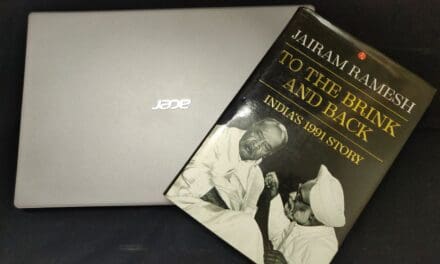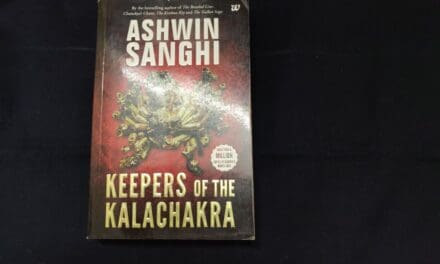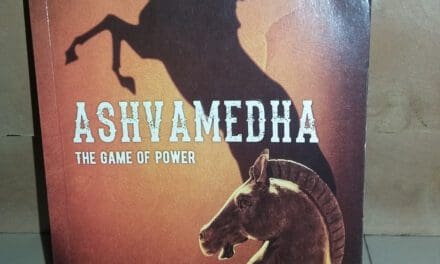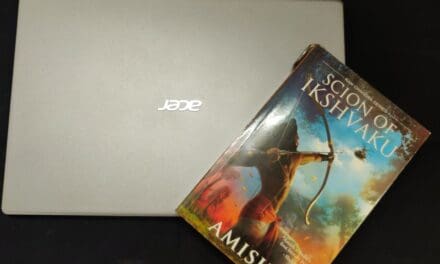First time I am writing a blog on a book that I have read and the book is Scion of Ikshvaku by Amish Tripathi. At first, I want to say that this was the book of Amish for me. I have read any book of his very famous Shiva Trilogy. So it was excitement and surprise for me. It took almost 10 days to finish this book and that experience is worth sharing.
Starting from the cover page, the design clearly shows Pushpak of Raavan and Ram aiming at it. This is very nicely designed and is eye-catching for sure. But the thing I liked more is the line written on the back cover “Ram Rajya, the perfect land. But perfection has a price. He paid that price”. That line surely sparks some emotions that a follower of Ramayana has inside.
I pre-ordered this book so got it with the digital signature of Amish and a metallic bookmark by Amazon. As a book with paperback, I was not expecting a hardcover-like experience but still, the quality of the cover is too bad. Cover bent within a few chapters of reading. Once I finished reading, I had to keep weight on the book for the entire night to make it straight. I wish Westland Limited had given better quality cover.
Anyway, the package is of less importance but the product is precious. The second good thing (After that line written on the back cover) that I noticed is that Amish has given a one-line introduction of every character, it makes reading easier.
Unlike my expectation, the real story starts with a war between Raavan and Dasharath. Till now everyone stated the birth of Ram as a day of joy for the entire universe, Amish describes it as the saddest day for Ayodhya and its king Dasharath. That was the moment I realize it is not going to be the ‘Ramayana’ way but this is Amish’s own Ram Chandra. Of course, it took a few minutes for me to feel comfortable with it. One new discovery about Ram Janam that made a good impression on me was a conversation between Nilanjana and the astrologer. It was a short part but one of my favorite books.
The rivalry between Kaushalya and Kaikeyi is stated amazingly. Initially, I liked it, especially the way Amish pen-down those political games the queens were playing. How Manthara influenced Kaikeyi and how Kaikeyi dominated Dasharath’s decision-making is worth reading. My mind yet refuses to accept that Manthara can actually BUY Kaikeyi for money; I mean anyway Ayodhya was never so poor that it cannot meet the demands of its king’s most favorite wife.
The education of all princes of Ayodhya is explained very beautifully. The character of Guru Vashistha and his way of teaching is nicely narrated. Discussion between prices and Vashistha is very enlightening and interesting. Even I liked the conversation of Ram & Vashistha about Asura and Deva. Laxman a protective brother and brave boy who is ready to take any risk to save Ram is simply admirable. Discussion about the feminine and masculine nature of society is long. For those who cannot read the same thing for long, it may become boring, but I personally liked it. However, the way the author introduced Radhika as Bharat’s sixth girlfriend is just annoying. Amish should have saved this imaginary story for some other book but this was a clear disaster. One just gets confused if he is reading about the scion of Ikshvaku or some college of a boy of the twenty-first century. Some things are better left in the original form.
One thing that I am totally unsatisfied with is Roshni’s part. Frankly speaking, I don’t understand the connection of that with other stories of the book. Amish has made a very clear attempt to put the Nirbhaya incident in this storyline but it still looks creepy. And most importantly, if Roshni was Manthara’s daughter and as the story highlights Manthara as the wealthiest person of Ayodhya, then where is Roshni’s father? In Ramayana, there’s no mention of Manthara’s daughter (as far I know). I understand that Amish has written more than half of the book with his imagination but still, that particular part is not going fine with the entire storyline. The execution of the punishment part is too exaggerated and violent. It would be better if the author had put some light on the thin line between justice and revenge. In short, I would happily eliminate the entire section of Roshni.
The introduction of Rishi Vishwamitra is very much as per his character, angry and energetic. It is very much like we are known from Ramayana. How Ram & Laxman fight with Tadka, her son and her army is interesting and makes you turn pages quickly. Even though there’s a little bit of modification by Amish, the changes are very small and enjoyable. The author has not played too much with it. The entire part of it goes well.
The introduction of Sita is coming at a very right time but it is not as romantic as Ramayana. In Amish’s version of the Ramayana, you will find that Sita is in conflict with one or the person most of the time. Sometimes with citizens of Mithila, sometimes with Raavan and men & sometimes with wild animals. Amish has changed the entire story of Swayamvar. He completely made it like Draupadi’s Swayamvar. The way Amish describes Mithila and the map of the city is sometimes boring. Or should I say it is a little bit confusing? After Swayamvar war with Raavan was a shocker. And how Ram was not willing to use Divya Astra was even more shocking. Yet I found it good to read.
The entire Vanvaas plot is again very much like Ramayana, so don’t want to write anything on it. Two boons of Kaikeyi, Ram requesting to banish himself and Site and Laxman going with Ram… Everything is too close to Ramayana. While Valmiki’s Ramayana sent Bharat to the jungle to take Ram’s paduka (slippers), Amish got it done in Ayodhya itself. Have to appreciate the political and logical meaning that Amish gave this story.
The journey of Ram, Laxman, and Sita to the forests was nicely written. Little bit changes are made here as well. Like Jatayu with them, Vibhishan & Surpanakha staying with Ram-Sita and Laxman… it is something unexpected. I found as Amish wanted fast forward the story here. The book ends when Raavan kidnapped and Hanuman is on his way to help Ram & Laxman.
The one line from this book I liked the most is “…Patriots are often called traitors by the very people they choose to serve, till history passes the final judgment.”
To end this blog which went bigger than I thought, I would give this book 7.5/10. I enjoyed this book and got annoyed at some stages. Appreciate the simple language Amish used throughout the book, you don’t have to keep the dictionary open while reading. I will wait for the second book of the Ram Chandra Series.
You can read more book reviews by me here.
































